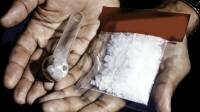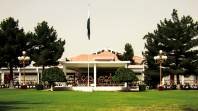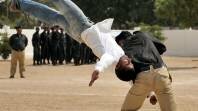Fahad was a meth addict for much of his youth. When he finally decided to quit, the withdrawal symptoms didn’t let him sleep for several nights at a stretch. He would throw up three to five times a day. Afterwards, his body would go numb.
Methamphetamine, a by-product of morphine popularly known as crystal meth, was introduced to him by friends while he was grinding out a living on the streets of Karachi. “It started with hash, then heroin and then I went through the ultimate experience—a friend introduced me to meth crystals,” he says, sitting at a rehabilitation centre run by Drug Free Pakistan.
Once a hard working young man with ambitions of improving his lot in life, the meth fueled direction Fahad’s fate went in turned out to be entirely different. “When I was high on the drug I forgot about all my fears--- it was pure euphoria. I could do anything to be able to buy it. But it came with its side-effects. I lost 15 kilograms of weight, I could not recognize my own self in the mirror.”
Meth has boasted a persistent rise in use since the heroin crackdowns starting from the late 90s. Unlike opium based heroin, amphetamine doesn’t leave an easily traceable or cross-border trail. It can be produced locally with off the shelf chemicals and medical supplies. Anti-narcotics authorities have also been slow to respond, this newer drug not having the social concern or political purchase of more established, poppy based vices.
It was not until the discovery of a meth lab in an upscale locality of Karachi that popular consciousness was stirred towards a problem already entrenched in the city’s streets. On November 28th, 2012 an explosion in a DHA apartment building near Bokhari commercial startled the police who thought terrorists were devising a bomb to attack the annual Muharram processions. A raid on the building busted a gang which was manufacturing the crystal meth.
Of the four accused of operating the meth lab the two Pakistanis, Mansoor and Haji Dawood, were arrested and subsequently confessed to the crime. Two other accomplices were of Iranian descent and escaped to their home country.
Iran is a big player in the global drug trade, and Karachi’s ports have often been used as a gateway to the rest of the world. But as with heroin in the past, the gateway cities end up nestling the most prolific users, ordinary people coming into contact with the movers and makers. People like Fahad.
Right now meth makes its way from Mauripur, a working class neighbourhood by the Karachi Port, to conflict riddled Lyari, Malir, Manghopir and then spreads across the city.
Though pricier than other street drugs — it goes for between Rs 500 to Rs 800 a gram—the white, ice-like substance, more addictive than any of its competitors, has managed to pervade the rich neighbourhoods and slums alike. A regular addict consumes about a gram day to meet his needs.
For the rich, the drug comes to them. “I get my dose from a trusted rickshawala, he comes to any spot I ask him to and I pay him after collecting the parcel,” says a student at IBA, one of the city’s elite universities.
For the poor, who make the largest portion of crystal addicts, the cost is taken care of by various gangs which infest lower income ghettos like the troubled Lyari. Teenage boys are introduced to the drug by a member of the gang—often a slightly older boy who the boys look up to.
“Once hooked to the drug these teenagers are ready to do anything for another dose. They pick up weapons and work as child soldiers often dying a young and tragic death,” explains Fahad, whose own story mirrors the one above, apart from the conclusion.
He says it was religion that saved his life.
“I begin attending a mosque regularly, where a Maulvi Sahab counseled me to leave the bad habit. By then I had realized how meth had almost driven me nuts—I would go for days without bathing, I did not feel hungry.”
For rehabilitation he arrived at a centre run by Drug Free Pakistan for addicts like him. “I was counseled. They taught me to look out for symptoms and triggers of urges, I began praying a lot more. It felt good.”
After checking in and out of the centre for six years, which included periods of long absences he spent on the streets hooked to meth again, he has finally gotten rid of his addiction.
“I haven’t touched any drug for years now. I am happy. God has given me a new life. I can’t thank him enough.” Now Fahad spends his days as a volunteer at the centre helping addicts who visit for treatment. Helping others isn’t proving an easier task.
“Crystal is the ultimate addictive drug. Half its amount gives double the high of heroin. To be able to buy it, addicts will do anything; from mobile snatching, robbery, vandalism and even sexual favours,” says Dr Sohail Yonus, president and counselor at Drug Free Pakistan.
Rehabilitation centres of the city report that over the last three years cases of crystal meth among drug addicts have seen a meteoric rise.
“Previously we had more cases of heroin addiction but now we are seeing a new trend. Patients who are addicted to crystal are turning up at our centres by the droves,” confirms a doctor at the Edhi Rehabilitation Centre.
A survey conducted in 2011 by the Ziauddin University Hospital puts the number of meth users in the city right now to a conservative 5 percent of the estimated 1 million total drug users. But these 50,000 regular users have popped up in a very short time. As of 2014, that number is projected to have doubled.
Once, the number of young men that came for meth rehabilitation used to make Fahad feel less alone, less isolated, it was a source of mutual encouragement; now that number frightens and disheartens him.
Crystal meth burns up the body’s resources at an alarming rate and systemically destroys regenerative capability, leading to memory loss, starvation, brain damage, psychosis and plethora of heart problems. Of the many things we lose our youth to in this country, extremism, poverty, disease, nothing paints a more abjectly horrible picture than the hollowed out shells of meth addicts.
The writer is a journalist based in Karachi.





















